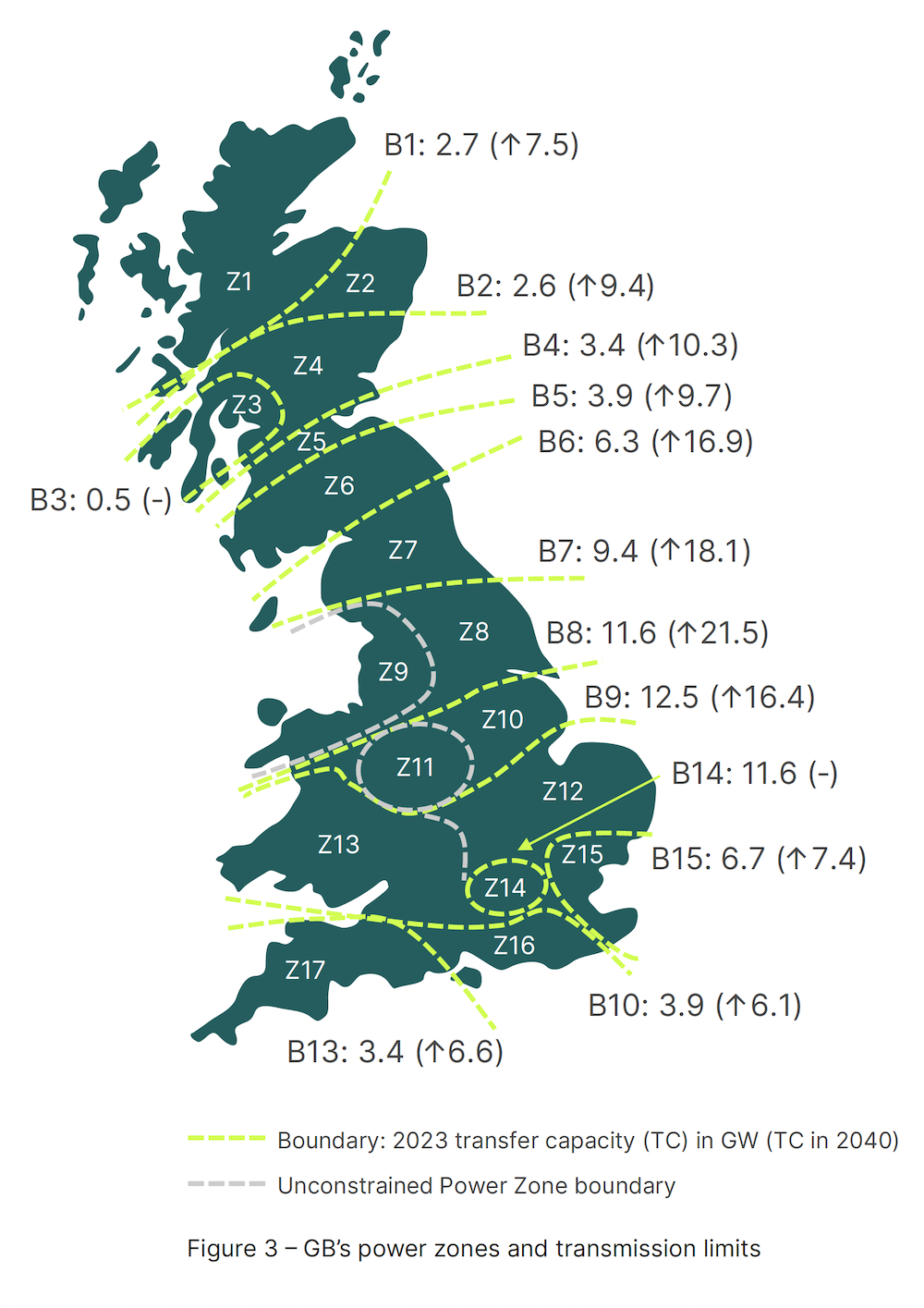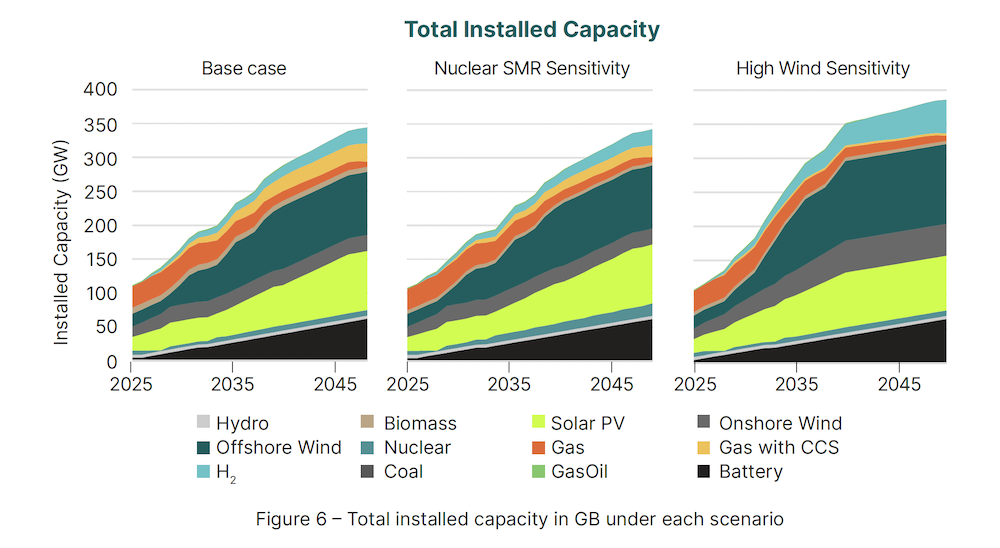About three years from now, some 80 miles off the coast of Yorkshire, England, the world’s biggest wind farm is scheduled to begin operation. The facility, called Dogger Bank — which will be powered by GE Vernova’s Haliade-X 14-megawatt (MW) wind turbines — is expected to generate 3.6 gigawatts (GW) of electricity, an amount equivalent to that needed to power 6 million homes in the U.K. Already the country has 25 GW of installed wind capacity, the equivalent amount needed to run two-thirds of the nation’s homes.
Wind power has arrived in the North Sea in a big way — and it’s not a minute too soon. Wind is a key part of Britain’s plans to achieve net zero carbon emissions by 2050. In 2019, the U.K. became the first major economy to make such a target legally binding. Two years after that, it added interim targets for 2035: a net-zero power system and a 78% overall reduction in emissions. These are ambitious goals that will require overhauling the electrical grid and adding renewables capacity that equates to a whopping 2.5 times the entire power capacity in Great Britain today, according to Martin O’Neill, vice president of strategy at GE Vernova Gas Power.
Yet the U.K. has laid out robust plans to reach net zero, calling on onshore and offshore wind in Scotland, solar arrays on England’s South Coast, new nuclear capacity, hydroelectric, biomass, carbon capture and sequestration, and, further ahead, hydrogen fuel technologies. Perhaps more than any other nation, the U.K. is placing its eggs in several different baskets in its effort to reach its net zero target.


“What differentiates the U.K. from some of its continental peers is a belief system that is quite anchored in common sense: no silver bullets,” said O’Neill at a recent media roundtable. “There isn’t one technology that solves for a net-zero future. You need to embrace nuclear as much as you do existing gas turbine plants as much as you work to grow wind and solar assets.”
O’Neill was discussing a study that GE Vernova recently released, entitled “Reaching Net Zero Carbon in Great Britain.” The detailed report lays out a framework of possible pathways the country could take to hit its targets, with recommendations on the most important near-term actions needed. The study was part of a response by GE Vernova to the U.K. government’s call in the past year for input from industry as the country reassesses its electricity market design.
In GE Vernova’s estimation, the next three to five years are a crucial period in which the U.K. government needs to take specific tangible actions. “We’re trying to put physics- and technology-based studies on the table to help get away from dialogue at 50,000 feet and to bring it down to breathable oxygen, where action can actually be taken,” says O’Neill.
Of Digital Twins and Least-Cost Pathways
To assess the U.K.’s pathways, the team created a “digital twin” of the nation’s current power system, using power system modeling software, explains one of the study leaders, Beth LaRose, energy transformation director at GE Vernova. They divided the island of Great Britain (the study did not include Northern Ireland) into 17 transmission zones, based on the same zones used by the U.K.’s grid operator, National Grid ESO.
The team offered several scenarios, but in all of them the biggest burden in the future energy picture would be carried by offshore wind, with appreciable contributions from onshore wind and hydrogen-fueled generation. Smaller but significant pieces would be added by solar, nuclear — including small modular reactors, or SMRs, like the GE Hitachi BWRX-300 — biomass, hydroelectric, and gas power plants with carbon capture, while legacy gas and coal plants would be phased out over the course of the 2030s.
And this all must happen even as the demand for electricity grows, with more and more consumers installing heat pumps and buying electric vehicles. To achieve net zero, the report concludes, 244 GW of added renewables capacity will be needed. “That’s a huge number,” says O’Neill. “We’re talking about multiplying the existing U.K. grid by more than two and a half times. Do you feel the sense of urgency?”
There are reasons for optimism. “The U.K. can actually meet net-zero commitments,” LaRose says. “There are multiple opportunities for the U.K. to reach those targets.” Households in Scotland get 85% of their electricity supply from renewables, more than half of that from wind. Solar farms are churning out power in southern England and Wales. And this year the government said it would be investing £20 billion ($25.7 billion) each in small modular reactors and carbon capture and sequestration, which many believe to be a necessary bridge to allow natural gas combustion to continue while drastically reducing CO2 emissions. Looking further ahead to when hydrogen fuel becomes more viable, the country set a target of having 5 GW of low-carbon hydrogen capacity in place by 2030 to help power the industrial sector.

Grid Lock
The biggest challenge, in fact, won’t be finding and building the right renewables. It will be the grid. To bring the wind-generated electrons from the far north coast of Britain and the solar power up from the south to the major load centers in the Midlands and London will require a complete overhaul of the existing grid. It will also mean siting projects like combined-cycle gas plants closer to London. “The transmission grid is key to the whole energy transition in Great Britain and almost everywhere else in the world,” LaRose says.
As a more variable energy picture takes shape, a digitized and better-orchestrated grid will be needed to manage it all. Moving electrons to the right places at the right times will require expansive new digital highways coordinated by solutions such as GE Digital’s GridOS. In addition, the island will need some 60 GW of battery energy storage systems.
What will all this cost? “More than a £50 billion [$64 billion] investment, twice as much as that of the past five years, is required in power generation and storage capacity alone this decade,” the study concludes. Which means it’s incumbent on the U.K. government to turn words into actions, and soon. Most urgently needed, O’Neill says, is market reform that is “technology agnostic,” meaning it provides incentives for equipment manufacturers to invest without fear that their technology will be left out in the end.
“In any net-zero trajectory, there’s a belief system that renewables need to increase by 300% between now and 2030. If none of the wind turbine manufacturers are making an acceptable return, where’s that 300% capacity growth coming from in the supply chain? We [GE Vernova] have the solutions and we’re making the investments, but we’re making a bet, because the market design — the economic stimulus — isn’t there.”
It’s a dilemma faced all over the world. But Britain’s legally binding commitment may put it in the best position to get over the net zero line on schedule and provide a model for other countries. “It’s not that the U.K. is behind,” O’Neill says. “I actually think they’re at the vanguard, which I celebrate and encourage. But we can’t continue this effervescent narrative. We have to get to meaningful, targeted action.”
